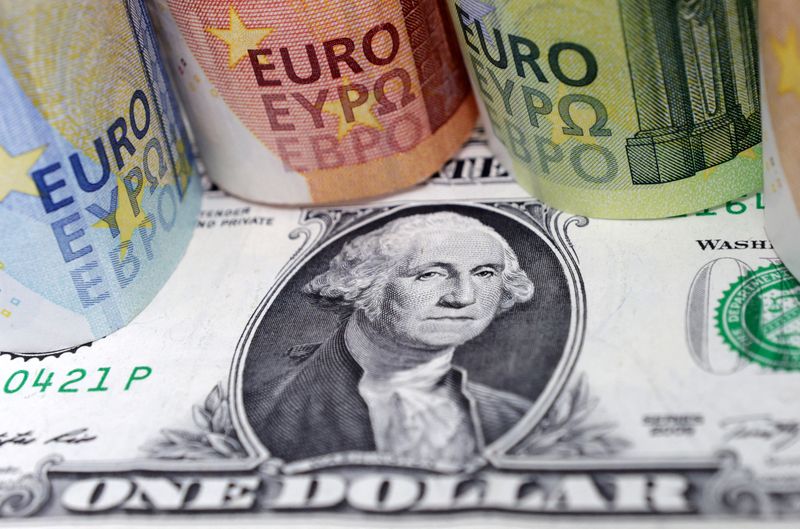Forex
Dollar falls, traders price for rate cut by May


© Reuters. FILE PHOTO: U.S. Dollar and Euro banknotes are seen in this illustration taken July 17, 2022. REUTERS/Dado Ruvic/Illustration/File Photo
By Karen Brettell
NEW YORK (Reuters) -The dollar fell against the euro and yen on Thursday as investors continued to bet the Federal Reserve is closer to cutting interest rates, even after Chairman Jerome Powell said that a move in March was unlikely.
Powell said on Wednesday that rates had peaked and would move lower in coming months, with inflation continuing to fall and an expectation of sustained job and economic growth.
But he declined to declare victory in the bank’s two-year inflation fight, vouch that it had achieved a sought-after “soft landing” for the economy or promise that cuts would come as soon as the March 19-20 meeting.
“The common theme that’s emerging from central bankers is a reluctance to indulge the market’s pricing on rate cuts,” said Adam Button, chief currency analyst at ForexLive in Toronto.
The dollar initially bounced on Powell’s comments that a rate cut in March is not the “base case,” but weakened on Thursday ahead of key jobs data on Friday.
Traders are now pricing in a 39% probability of a March rate cut, and a 94% chance of a rate reduction by May, according to the CME Group’s FedWatch Tool.
“Even though Mr Powell is out there saying directly we’re not ready to do this, the markets keep moving their anticipation for the first rate cut to the next meeting,” said Joseph Trevisani, senior analyst at FX Street in New York.
Traders are expecting an economic slowdown, but they “haven’t gotten it yet”, he added.
Friday’s jobs report for January is expected to show that employers added 180,000 jobs during the month.
Data on Thursday showed that U.S. fourth quarter worker productivity grew faster than expected, while initial claims for state unemployment benefits increased in the latest week. U.S. manufacturing also stabilized in January amid a rebound in new orders.
The was last down 0.55% at 103.04.
The greenback has also been pulled lower by tumbling Treasury yields on renewed jitters over U.S. regional banks. A sell-off in shares of those banks continued on Thursday, adding to losses from a day earlier when New York Community Bancorp (NYSE:) reported pain in its commercial real estate portfolio.
Those concerns may have also boosted the safe haven Japanese yen. The greenback lost 0.45% against the Japanese currency to last trade at 146.29 yen.
The Bank of England, meanwhile, adopted a slightly more hawkish tone on Thursday, even as it dropped its warning that “further tightening” would be required if more persistent inflation pressure emerged.
BoE Governor Andrew Bailey said that “we need to see more evidence that inflation is set to fall all the way to the 2% target, and stay there” before rates can be lowered.
“While the ECB and the Fed are hinting at rate cuts, the Bank of England’s reticence for these discussions continues to make it stand out as an outlier,” said Kyle Chapman, FX market analyst at Ballinger & Co.
Sterling gained 0.46% on the day to $1.27455.
The euro rose 0.5% to $1.08720, after earlier dropping to $1.07800, the lowest since Dec. 13. The single currency has been hurt by expectations that the U.S. economy will hold up better than that of the euro zone.
The other rate decision on Thursday was from Sweden’s Riksbank, which kept its key interest rate unchanged at 4.00% as expected. The bank said that if inflation continued to slow it might be able to bring forward the timing of a first rate cut, possibly even to the first half of 2024.
Sweden’s crown was steady against the dollar at 10.39.

 Forex3 years ago
Forex3 years agoForex Today: the dollar is gaining strength amid gloomy sentiment at the start of the Fed’s week

 Forex3 years ago
Forex3 years agoUnbiased review of Pocket Option broker

 Forex3 years ago
Forex3 years agoDollar to pound sterling exchange rate today: Pound plummeted to its lowest since 1985

 Forex3 years ago
Forex3 years agoHow is the Australian dollar doing today?

 Cryptocurrency3 years ago
Cryptocurrency3 years agoWhat happened in the crypto market – current events today

 World3 years ago
World3 years agoWhy are modern video games an art form?

 Commodities3 years ago
Commodities3 years agoCopper continues to fall in price on expectations of lower demand in China

 Economy3 years ago
Economy3 years agoCrude oil tankers double in price due to EU anti-Russian sanctions



























